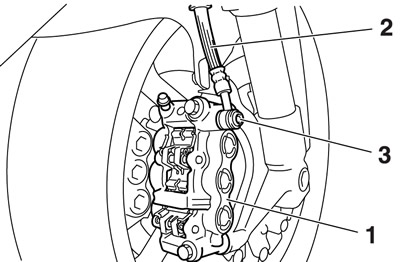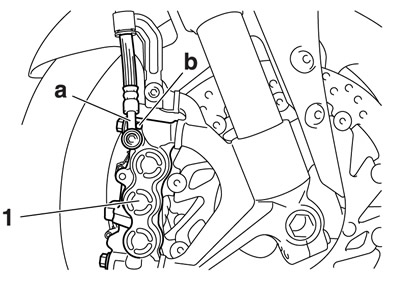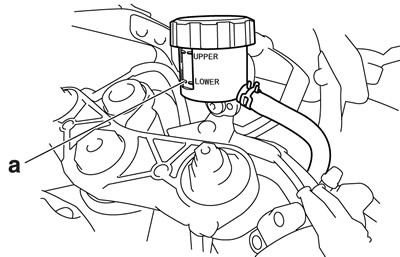1. Install:
- Brake pads
- Brake pad springs
- Brake pad pins
2. Install:
- Brake caliper "1"
- Copper washers New
- Brake hose "2"
- Union bolt "3"
- Brake hose holder
Front brake caliper bolt 35 Nm (3.5 m·kgf, 25 ft·lbf).
Front brake hose union bolt 30 Nm (3.0 m·kgf, 22 ft·lbf).
Front brake hose holder 6 Nm (0.6 m·kgf, 4.3 ft·lbf).

Proper brake hose routing is essential to insure safe vehicle operation. Refer to "Cable routing".
Notice: When installing the brake hose onto the brake caliper "1", make sure the brake pipe "a" touches the projection "b" on the brake caliper.

3. Fill:
- Brake fluid reservoir (with the specified amount of the recommended brake fluid)
Recommended fluid DOT 4.
Warning:
- Use only the designated brake fluid. Other brake fluids may cause the rubber seals to deteriorate, causing leakage and poor brake performance.
- Refill with the same type of brake fluid that is already in the system. Mixing brake fluids may result in a harmful chemical reaction, leading to poor brake performance.
- When refilling, be careful that water does not enter the brake fluid reservoir. Water will significantly lower the boiling point of the brake fluid and could cause vapor lock.
Notice: Brake fluid may damage painted surfaces and plastic parts. Therefore, always clean up any spilt brake fluid immediately.
4. Bleed:
- Brake system. Refer to "Bleeding the hydraulic brake system".
5. Check:
- Brake fluid level
Below the minimum level mark "a" → Add the recommended brake fluid to the proper level.
Refer to "Checking the brake fluid level".

6. Check:
- Brake lever operation
Soft or spongy feeling → Bleed the brake system.
Refer to "Bleeding the hydraulic brake system".
